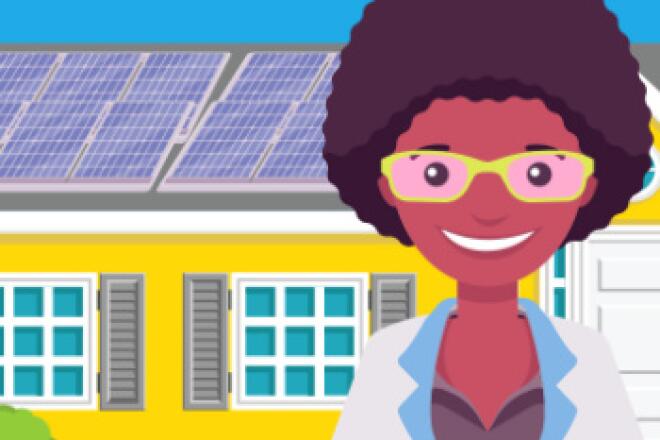
How We Get Energy
Energy is a fundamental part of our day-to-day lives. We use energy to light, heat and cool our homes, transport us, communicate with others and power our everyday activities. Most of us take for granted that when we flip the switch, the lights go on. But did you know the electricity system that provides power is changing dramatically?
Most consumers get their electricity from power plants partly fueled by coal or natural gas, but that’s rapidly changing. Consumers increasingly get their electricity from cleaner, greener, renewable sources including solar and wind. Read on to learn more about some of these amazing innovations.
Utilities and entrepreneurs alike are working to make energy more sustainable and more affordable
Providing consumers with easier access to solar
Consumers in some parts of the country can shop online for solar power for their homes. The process is fairly simple where you can enter your zip code and get quotes from qualified, pre-screened solar installers and contractors.  And local grassroots nonprofit organizations like SmartPower and some utilities like National Grid are getting into the act to help customers and local residents learn more about and install solar power on their homes. In some states when the rooftop solar output exceeds your home’s needs, the excess is sold back to the grid, enabling you to earn money for that extra power.
And local grassroots nonprofit organizations like SmartPower and some utilities like National Grid are getting into the act to help customers and local residents learn more about and install solar power on their homes. In some states when the rooftop solar output exceeds your home’s needs, the excess is sold back to the grid, enabling you to earn money for that extra power.
Using batteries to store energy for later use
New technologies like home battery storage are increasingly available at an affordable price. This technology will enable you to store and use energy from solar or other energy sources in your home during a power loss, or when the sun is not shining during evenings and cloudy days. Utilities like Green Mountain Power in Vermont are working with companies like Tesla to provide affordable battery storage solutions for residents, who get paid for helping stabilize the electric grid.
Innovation is creating exciting new ways to generate sustainable energy for individual homes and communities
Windows that let the light in and generate electricity
Companies like Onyx Solar have developed solar windows which contain photovoltaic glass, a semiconductor material that converts sunlight into electricity.  The windows not only can generate electricity, they can filter out harmful ultraviolet and infrared radiation. And companies like Tesla have developed solar shingles that replace conventional roof shingles on homes with durable, long-lasting ones that make a home look beautiful and generate electricity!
The windows not only can generate electricity, they can filter out harmful ultraviolet and infrared radiation. And companies like Tesla have developed solar shingles that replace conventional roof shingles on homes with durable, long-lasting ones that make a home look beautiful and generate electricity!
Using roads for more than just getting there
Energy-generating materials are not limited to buildings. Engineers at Solar Roadways are developing a modular system of solar panels that you can walk and drive on. In addition to generating electricity and being extremely durable, the panels’ embedded technology helps keep them ice and snow free! Although the company says the solar road panels are still in R&D, they’ve been awarded several contracts from the U.S. Department of Transportation to help keep things moving.
Energy innovations are also making our electric grid more reliable and dependable
The damage to the East Coast electrical grid by Superstorm Sandy in October of 2012 spurred interest in two innovations that are affecting the entire flow of energy throughout the electric grid:
 Reducing the vulnerability of the grid through improvements
Reducing the vulnerability of the grid through improvements
Utilities and governments have made investments to reduce the vulnerability of the overall electrical system through grid hardening. Smart grid technology improvements, including over 70 million smart meters along with strengthening distribution infrastructure and underground strategic areas, help prevent outages, improve restoration times and communicate real time during storm events with customers through social media.
Making the overall grid more reliable by interconnecting smaller ones
Smaller electric grids connected together, called microgrids, have their own source of electricity and can be self-sufficient power-wise, much like an island. So the houses and buildings connected to a microgrid could continue getting electricity even if power is knocked out elsewhere. Several neighborhoods in Brooklyn, N.Y. have banded together to create a microgrid of their own. Some of the residents are actually generating their own electricity via solar panels on their roofs. If they generate more energy than they need, they sell the extra power to their neighbors connected to the microgrid.
“Look Ma, No Wires…”
Charging your digital device (or vehicle) without plugging it in
As many travelers know, the hardest thing to find is an available electric outlet for charging your smartphone. There are companies like WiTricity developing a new technology known as wireless electricity transfer that can wirelessly charge smartphones, laptops and tablets without the need for cables or power cords. The technology does not transfer electricity through the air, but instead relies on the concept of “magnetic resonance” to transfer electricity via a magnetic field.
This technology is also being developed to wirelessly charge electric vehicles (EVs) to address range anxiety, one of the more common barriers to EV adoption. Some engineers and entrepreneurs are working on solutions where the wireless charging equipment is embedded into the streets and roads themselves so that vehicles can automatically recharge while they are driving down the road. This charge-asyou- drive system would mean that you essentially could drive for an unlimited amount of time without having to stop and recharge the vehicle’s battery.
What do these innovations mean for you?
Our world depends on sustainable sources of energy that serve the needs of the present without compromising the ability of future generations to meet their energy needs. With advanced energy innovations outlined here and others yet to come, new and cleaner energy sources are increasingly within your reach. Even more exciting, these new ways to produce clean energy mean a reduced carbon footprint.
Download this fact sheet.
Watch the video.



